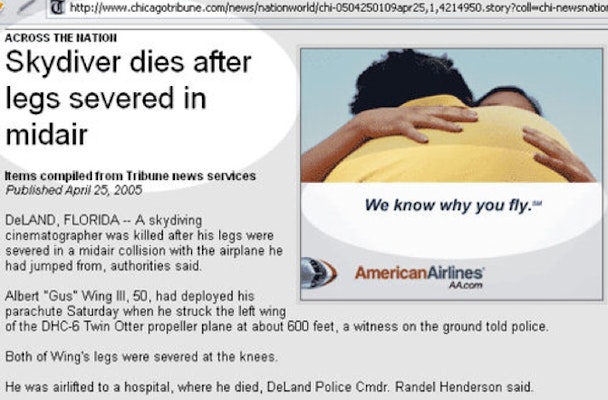Advertisers double-down on brand safety to spare their blushes
Advertisers doubling down on brand safety are asking some of the world's leading publications to implement technology that can save client blushes over ads being served next to quality content in an inappropriate manner.

This technology helps advertisers steer clear of negative high-profile news stories concerning their industry verticals, such as an airline not wanting to have its ads served next to an article covering a plane crash or a car marque not wanting to have an ad served next to articles about Volkswagen's recent fuel emission scandal.
WPP's ad tech unit Xaxis has confirmed to The Drum it is working with contextual targeting service providers in order to minimize the risk of potentially embarrassing automated ad placements in editorial environments that are normally deemed as 'brand safe', such as The New York Times.
While such editorial titles are deemed as highly desirable environments to buy media, the shift towards programmatic - or automated - media buying technologies (where placement is often trusted machines with minimal human curation) brings with it some areas of concern for brands.
The increased usage of such contextual targeting technologies progresses the content verification debate which has been spurred by the shift towards programmatic media buying.
Brands including Nationwide have been criticized for not employing content verification tools and appearing against dubious content, but now quality editorial titles are seeing to make further assurances to media buyers.
The New York Times also confirmed to The Drum that it is using such content verification technologies, with ad tech outfit Grapeshot, also claiming that advertisers are increasingly asking to use the technology.
The company offers a service called Keyword Blacklisting which can be used during incidents such as an automotive recall, where it creates blacklists around specific keywords for instance a car brand won't be served against articles containing words such as 'recall', or phrases such as 'fuel emissions', etc.
Nicole Brodeur, Grapeshot, senior client services manager, explains that the company can monitor news cycles and then detect negative stories, which could involve an advertiser (either directly, or indirectly), and then create custom segments for brands in specific industry verticals.
This is then used to steer advertisers away from such articles, whether or not they are directly involved or inadvertently embroiled. For instance, if a hostage siege is taking place in a fast-food restaurant then Grapeshot can apply its algorithmic targeting software to ensure its advertisers in the same sector won't serve ads against articles discussing the story.
Brodeur explains that Keyword Blacklisting is a new application of existing technologies, with the service having been in beta for some months ahead of a full product roll out, with brands currently using the service emanating from the automotive and FMCG/CPG verticals, as well as others.
It also has integrated the technology across the industry's leading demand-side platforms (DSP) and expects further take up from advertisers given that the U.S. is about to enter a presidential election year, where coverage is likely to be extensive, and often politically divisive, areas where brands are often afraid of being dragged into.
"In a very scandal-led news agenda, this can help you manage your brand's signature across the internet," says Brodeur.
See gallery below for images containing instances of unfortunate ad placement within premium editorial environments.
Words by Ronan Shields and Minda Smiley
Ad misplacement examples
Ad misplacement
admisplscement2.jpg

admisplacement4.jpg


